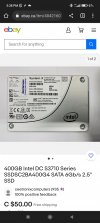I bought for my homelab the last years:
10x S3710 400GB
8x S3710 200GB
2x S3700 400GB
2x S3700 200GB
2x S3700 100GB
All got wear between 0-4% when I bought them, even when they already ran 24/7 for 6 years in someone's server. Off all those disks only one S3710 400GB failed after a year or so. I guess the controller failed, as all the SMART attributes looked absolutely fine (3% wear if I remember right) until that SSD wasn't recognized anymore.
When buying them I first ask the seller if he can use the free smartctl/CrystalDiskInfo to show me the SMART attributes. With that I can decide if that SSD is in good condition or not (especially have a look at the "233 Media_Wearout_Indicator" for the wear, "175 Power_Loss_Cap_Test" for the PLP and "9 Power_On_Hours" to know how long the SSD was in use. "5 Reallocated_Sector_Ct", "171 Program_Fail_Count", "172 Erase_Fail_Count", "184 End-to-End_Error", "187 Reported_Uncorrect" and "199 CRC_Error_Count" should be 0).
If the seller can't or doesn't want to provide me with SMART data I only buy it if it as a good deal and sold as tested and working. For example, some years ago I bought 2x S3700 100GB for combined 25€ incl shipping which is great as a boot mirror. And some months ago I bought 2x S3700 400GB for combined 50€ incl shipping. Even those SSDs, which I didn't know the condition, none of the SSDs got more than 4% wear.
Those are real workhorses. My homelab is writing over 1TB per day and I think none of the SSDs actually climbed above 4% wear yet

PS:
There are also 1.8" and SAS models, so look twice before buying them.
There is a datasheet going really deep into the details including what every SMART attribute means, which you don't often see:
https://www.intel.com/content/dam/w.../product-specifications/ssd-dc-s3710-spec.pdf
And the old Intel tool for changing settings (you can switch between 512B/4K sectors, limit power consumption, encryption, protection mode so you can't secure_erase it by accident, ...), updating the firmware or doing a secure_erase (I would recommend doing both when you get them) isn't available anymore, as these are now sold as Solidigm instead of Intel. But the Solidigm Storage Tool works fine for that:
https://www.solidigm.de/support-page/drivers-downloads/ka-00085.html


